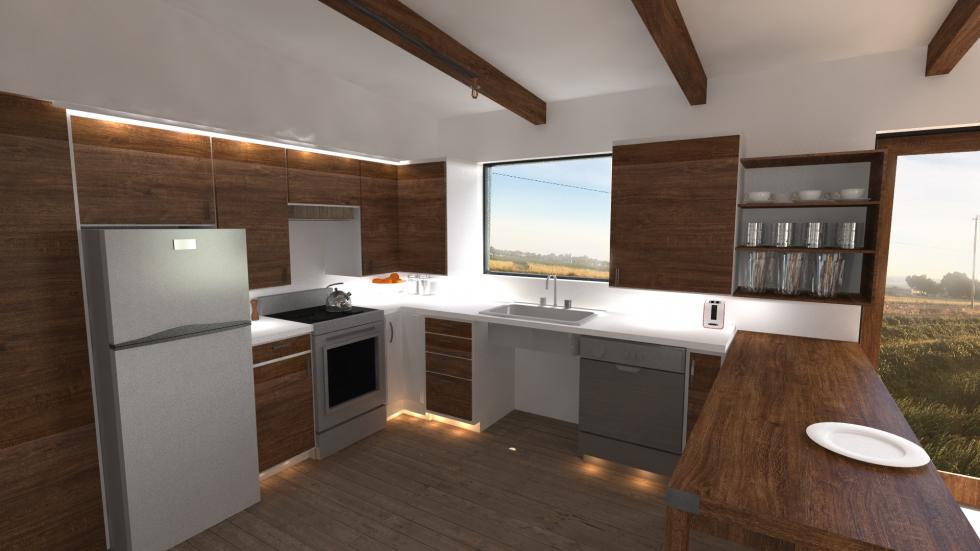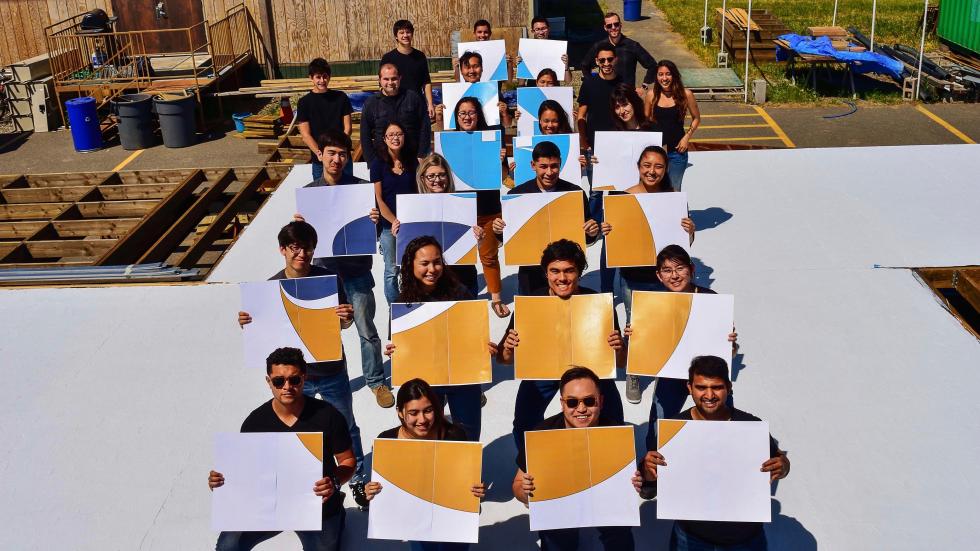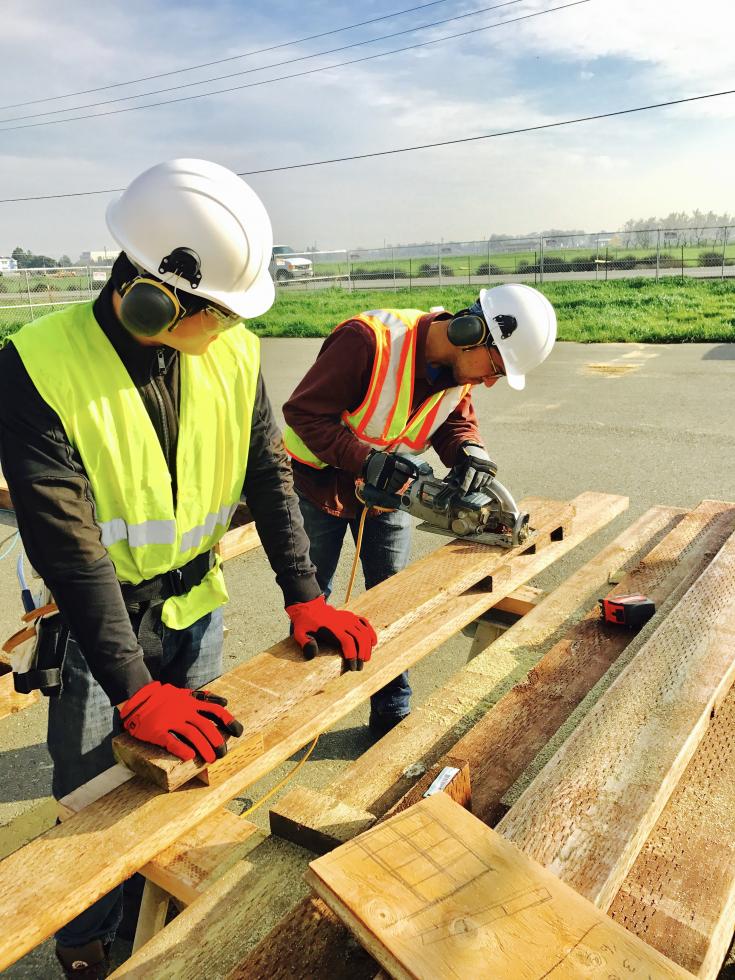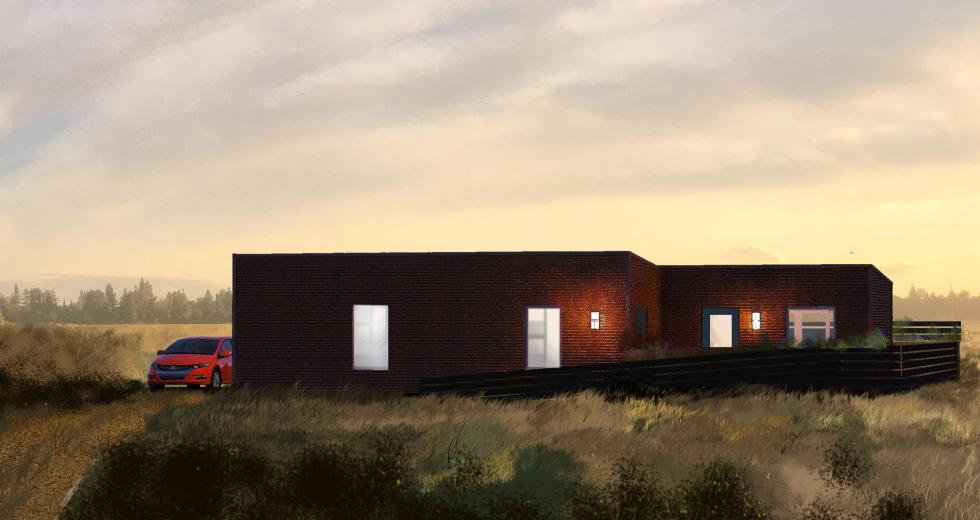Students at UC Davis are building a house. Not just any house, but a solar-powered house, one with the potential to be as affordable as it is innovative and, above all, energy efficient.
The students are participants in the U.S. Department of Energy’s Solar Decathlon, a competition that takes place every two years. The Davis crew is one of 15 teams selected to compete this year, and one of only two coming from California (the other team is from UC Berkeley). This year’s event will take place in October in Denver, but the actual construction of the house is well underway in a lot just off of Hutchinson Drive, in the UC Davis West Village area.
The construction of the roughly 913-square-foot home marks another step in a two-year process that began with design and ends with a testing phase. Once the house has been completed and screened for any issues, the team will disassemble it, drive it to the competition site in Denver and reassemble the structure for a panel of judges — all within an intense timeframe of eight days.
The interior of the houses has energy-efficient and
water-conservation features. (Photos courtesy UC Davis Solar
Decathlon Team)

The events that make up the Solar Decathlon include architecture, market potential, engineering, communications, innovation, water, health and comfort, appliances, home life and energy. Of these categories, water and innovation are newcomers for 2017, and it’s these two debut categories that the UC Davis team is primarily targeting, says Geoffrey Mangalam, a 23-year-old undergraduate sustainable agriculture and food systems major. Mangalam is also one of two student project co-managers.
“The house itself is being built in response to the California drought,” Mangalam says, noting that while conditions have recently lessened, droughts in the state have a historical precedence of reoccurring.
To encourage those who dwell within to conserve water, the house will have a number of features, including usage meters at every fixture from which water is dispensed. For example, someone doing dishes or taking a long shower will be able to glance at a real-time report of how many gallons they’ve used, complete with a gauge of targeted projections for responsible consumption.
The UC Davis team includes dozens of students over the two-year
process. (Photos courtesy UC Davis Solar Decathlon Team)

The students have dubbed their project Our H2Ouse, pronounced simply as “our house.” It’s a zero-energy-ready home that the team projects has the potential to cut the typical water use of a household in half, while still offering a comparable level of comfort and an affordable price point. According to the U.S. Department of the Interior’s U.S. Geological Survey, the average person uses between 80-100 gallons of water each day.
Students have been careful to make sure the house’s features don’t come across as a lecture on habits and lifestyles, so they also plan to add aesthetic touches, such as art that prominently features water. The aim is to keep responsible water usage always on the forefront of the occupants’ minds.
The UC Davis team also participated in the decathlon in 2015, taking home two first place finishes, one for affordability and one for commuting, held that year in Irvine. The house built that year was a zero-net energy house designed for farmworkers.
Students work on building their house for the Solar Decathlon.
(Photos courtesy UC Davis Solar Decathlon Team)

The 2017 competition marks the first year that teams are eligible for cash prizes, ranging from $300,000 for first place down to $100,000 for fifth. Overall, the last UC Davis team finished seventh out of the 15 entrants.
The Department of Energy hosts this competition for three reasons: to educate students and the public about the money-saving opportunities and environmental benefits of clean energy products and designs, to demonstrate to the public that energy-efficient homes can be both comfortable and affordable, and to give participants unique training that prepares them to bring clean energy practices into the workforce.
After the competition, some houses are sold to recover costs and raise money for future teams. The majority, however, are used for research, and some are put on display for public tours at the universities that built them. The DOE estimates that the contest, which started in 2002 (before being held biennially beginning in 2005) has already translated into benefits for society at large. According to the agency’s website, more than 18,000 students have competed, and the contest has led to similar events in locales that range from Spain to China to the United Arab Emirates. As a result, clean-energy building practices from the competition have advanced residential building techniques throughout the planet.
(Photos courtesy UC Davis Solar Decathlon Team)

The undergraduate and graduate students on this year’s team come from multiple disciplines across campus, such as design, engineering and communications. They have a faculty adviser in engineering professor Frank Loge, who is director of the UC Davis Center for Water-Energy Efficiency, as well as on-site leadership from graduate student Tom Ryan, a veteran of the 2015 Davis competition team.
The students, while often versed in the academic side of engineering, are far from experts in actual physical construction, a vital skill set seeing as they’re building a house. But expertise from past teams has been passed down, and the excitement over the potential benefits for the environment is nearly palpable at the work site.
Workers come and go frequently, with classes and student life dictating willingness and availability. The students listen to music, go for lunch together, and share jokes and encouragement as they hoist the walls into place. They take breaks in an on-site trailer complete with computers and even a lounge area with a pool table.
While few knew much about the practical aspects of homebuilding at the start, you wouldn’t know it when watching them work, calling out construction jargon to each other, wearing hardhats and hoisting heavy equipment such as sledgehammers.
For Shehab Faghri, a 26-year-old structural engineering student originally from Iran, the construction aspect of the competition has been an invaluable one. Faghri says being out on site every day, gathering practical skills, has helped him become a better engineer.
“A lot of designs I used to make were unrealistic for builders,” Faghri says. “Now I’ve been in their shoes. I’ve put actual nails in the walls.”



